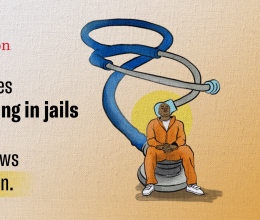
My job is to sue prisons, and I love my work. My colleagues and I work to ensure the basic human dignity to people our society has locked up. But it is, more often than not, extraordinarily frustrating. Our clients, the human beings locked away in our criminal justice system, live in dire conditions. They are warehoused. Their medical and mental health needs are ignored. They are subjected to extreme physical violence. Just seeing and hearing about it is painful. And change comes all too slowly.
At the ACLU, we take heart from the little victories. Just before we go to a prison to see our clients, the bathrooms in their housing units are finally cleaned, the people in the prisons are finally given coats for when they go outside, and they are finally sent out for the medical visit that was ordered months or years ago. Unfortunately, the systemic changes to ensure people’s most basic needs are met take much longer, and are often met with resistance from prison personnel and administrations that do not believe their job is to meet those basic needs.
This year has been different. Back in June 2022, following a decade of litigation, U.S. District Judge Roslyn Silver found in Jensen v. Thornell that conditions in solitary confinement in the Arizona Department of Corrections, Rehabilitation and Reentry (ADCRR) violated the constitutional prohibition on cruel and unusual punishment. One year ago this week, she issued a sweeping injunction ordering ADCRR to bring the conditions of solitary confinement into compliance with the U.S. Constitution and basic standards of human decency.
Over the past year, ADCRR has made a great deal of progress, including preventing many vulnerable people from being subjected to the devastating effects that accompany solitary confinement. The department has also dramatically lowered the number of people in extremely long-term isolation, and has – to our knowledge – complied with the court’s order prohibiting any child under 18 from being placed in solitary confinement for any length of time.
Additionally, at the time of the order, there were 1,071 people housed in “maximum custody,” ADCRR’s euphemism for long-term solitary confinement. According to ADCRR, at least 200 people had been in maximum custody for a year or more, and six people had been in for over a decade. Today, there are just over 200 people in maximum custody – a reduction of more than 80 percent. Half the people who had been held in maximum custody for over a decade are no longer in solitary confinement.
The reduction in the solitary confinement population was so great that one facility, Arizona’s original “supermax” facility, was closed entirely in November 2023. This supermax facility had a reported capacity of 2,440 people, most of whom were held in solitary confinement.
There have also been significant improvements in conditions. People held in solitary confinement now receive three meals a day most days, whereas previously they received only two. In solitary confinement units where an electronic system has been installed to track movements, incarcerated people report that there is no longer a problem of being left in the shower for hours on end, as used to happen with some regularity. People are offered cleaning supplies and the housing units are treated by exterminators.
While the improvements – particularly the removal of people from long-term solitary confinement – are laudable, much remains to be done. The court ordered that one vulnerable group – people with serious mental illness – be kept out of solitary confinement altogether. There are housing units for people with serious mental illness, which ADCRR claims are not solitary confinement units. But the people inside report that they are locked in their cells more hours per day than people in the housing units ADCRR considers solitary confinement. Similarly, there is a prison in which people with dementia are held and are rarely let out of their cells, let alone allowed to go outside. There are still three people who have been in solitary confinement for over a decade. And many people remain in solitary confinement because either they themselves or ADCRR have decided that ADCRR cannot keep them safe in general population.
The proverbial low-hanging fruit has been harvested. The hard work of further reducing – and ultimately eliminating – solitary confinement in Arizona remains. It appears the ADCRR administration has the will to take on this difficult labor in pursuit of human dignity. This spring, one year into implementation of the Jensen injunction, I have hope.







